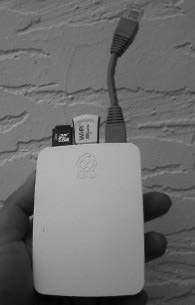$35 Hacking Machine
by InsideJob
O.K., it'll cost a little more but the basic quad-core, 1 GB RAM Raspberry Pi 2 is really only $35.
At minimum you'll also need $15 for a wireless keyboard/mouse, $10 for a microSD card, and $5 for a 5 volt, 2 amp power supply.
For the official case and USB Wi-Fi card, add another $20 or so. If you want to be mobile, get a Tzumi battery at Walmart that does "turbo charging." That's marketing boolshiat which means it outputs 2.1 amps. Part numbers for MCM Electronics are at the end of the article. Element 14 has been sending end users to that site for a few months and now only accepts corporate purchase orders.
Next, you'll need an operating system for your Hackintosh 2600.
I recommend Privacy Enhanced Linux because it comes pre-loaded with all the non-free drivers you'll ever need. Since it includes proprietary software that the others don't, you'll need to provide your own support. The author of the distribution is a mysterious leet hax0r from way back when there was music on MTV.
The 1.7 GB file is available at tinyurl.com/pelinux. Make sure you have at least 8 GB of free hard disk space, then follow these steps:
1.) Decompress the GZ file. Under Linux, you'll likely have a program like Ark (archiver) already associated with the extension, so just clicking the file should work. Under Windows, you might have to start your unzipping program first, depending on which one you use.
2.) Write the decompressed img file to a microSD card. With Linux, the built-in dd program works great. Just specify the img file with if= and the microSD card in a flash reader/writer should be something like of=/dev/sdb. Under Windows, you'll need a flash card writing program. Follow the Raspbian instruction if you don't already have one. You may also want to expand the root file system to fill your card at this point, as you can't do it while running the OS.
3.) Plug your Pi into an HDMI TV and boot your information warrior machine. If you have Wi-Pi or Edimax Nano, then you should immediately be able to connect to your access point via the slick Wicd (pronounced "wicked") GUI app. PELinux doesn't use Wicd for the wired LAN though.
Privacy Enhanced Linux plays MP3 audio files and MP4/AVI video straight out of the box. Unfortunately, the Pi "foundation" racket wants to charge extra for hardware accelerated decoding, but software decoding works well at native video resolutions. Odd full-screen resolutions don't resize well and bog down the wimpy processor. 3D gaming is simply out of the question. In the beginning, they showed it off playing Quake 3, but in reality all it can do is retro 2D gaming.
So what is it really good for? Well...
If you bought a crossover network cable, plug the Pi into a Windows laptop instead of your TV. You can then Remote Desktop to it at 10.0.3.14 as user pi with password pi.
I made a super short crossover cable myself for my Wintendo lappy (see pics). Once remotely connected, you'll find a whole slew of useful networking tools like Wireshark and EtherApe.
You'll also have a complete Apache web server running if you want to edit /etc/network/interfaces and reboot it on a publicly accessible address.
For the personal user, in addition to the usual productivity and office suites, you'll find a GPSd server that works with Microsoft's USB GPS in Streets & Trips, as well as many others.
The FoxTrot program can pull from Google satellite images for truly awesome navigating using real ground pictures, not drawn maps. Add a 7-inch touchscreen and you could even make a "car-puter" out of it. I'm using a WaveShare mini-HDMI screen for my prototype.
Of course, all of this remote control and Internet stuff comes with risks.
That's why Privacy Enhanced Linux comes with a firewall, anti-virus, and a rootkit hunter. As if that wasn't enough, it also uses IceWeasel with Privacy Badger and a custom /etc/hosts file that overrides even the most determined advertising redirectors.
There are a few "penetration testing" tools that may raise concerns, but they're for Windows systems so your Pi is safe.
To be sure, though, I recommend you su to root using password debian then change all the passwords.
That should make your $35 hacking machine bulletproof!
Part MCM# Price Raspberry Pi 83-16530 $35 5V, 2A PSU 28-19335 $4 Edimax WiFi 831-2761 $12 Official Case 83-16321 $9 UHS microSD Shop Around $15 Tzumi Battery Walmart |
www.youtube.com/watch?v=z5uPFvBr8lk Download the 6B ZIP from here: privacyenhanced.blogspot.com decompress then: sudo dd bs=4M if=privacyenhancedlinux64_beta6B.img of=/dev/sdb sync (flushes cache) insert the card into your Pi 3 and boot, administrator raz has a password of ubuntu2017 df -h shows card is almost full so run gparted from menu..system click the system partition click resize button expand the partition to fill the disk click green check button df -h shows plenty of room now
Privacy Enhanced Linux for Raspberry Pi 2 isn't just based on Debian, it IS Debian. The first release was on 9-11-2015 and was a "clean" image of Debian 8.2 stable for ARM hard float (32-bit with math co-processor/FPU) with a highly tweaked XFCE desktop. In fact, it's really my personal backup image that I decided to release as a distro. The 1.7 gigabyte microSD card image is here: privacyenhancedlinux_9-11.img.gz privacyenhancedlinux_murdock.img.gz privacyenhancedlinux64_beta6C.zip Default user password is "pi" and root password is "debian" RIP Ian Murdock


